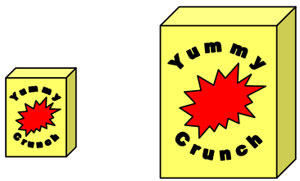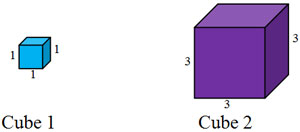
In this section, you will compare volumes of similar figures.
When you are shopping for groceries or just about anything that is sold in a box, it's important to understand how to compare different sizes of boxes and how much of a product the box holds.

The dimensions of the larger cereal box are twice the dimensions of the smaller cereal box.
To illustrate the differences in the volume of the cereal boxes, you are going to create a similar scenario by clicking on the Block Builder link above. In the new window/tab that launches, there will be a blue cube that measures 1 by 1 by 1. You are going to create a prism with dimensions 2 by 2 by 2 (twice the dimensions).
In order to create the new prism, drag a yellow cube from the upper right hand corner to the blue block. When the face you choose to attach it to turns red, the yellow block will dock with the blue block. Select another yellow block and continue until you have created the new prism.
Think about how many cubes it took to build the 2 by 2 by 2 prism, then answer the following:
How much more cereal can the larger box hold than the smaller box?

When the dimensions of similar figures are changed to create an enlargement or reduction, the scale factor describes the change in the dimensions and determines how much other measurements are changed.
Look at the two cubes shown. The smaller cube has dimensions of 1 by 1 by 1. The larger cube has dimensions 3 by 3 by 3.

Compare the perimeter, area of the bases, and the volume for the cubes by answering the questions below. Click on the blanks to check your answers.
Perimeter of base of Cube 1 = Interactive button. Assistance may be required. __________ 1 + 1 + 1 + 1 = 4
Perimeter of base of Cube 2 = Interactive button. Assistance may be required. __________ 3 + 3 + 3 + 3 = 12
What is the scale factor between perimeters? 4 x Interactive button. Assistance may be required. __________ 3 = 12
Area of base of Cube 1= Interactive button. Assistance may be required. __________ 1 x 1 = 1
Area of base of Cube 2 = Interactive button. Assistance may be required. __________ 3 x 3 = 9
What is the scale factor between areas? 1 x Interactive button. Assistance may be required. __________ 9 = 9
Volume of Cube 1 = Interactive button. Assistance may be required. __________ 1 x 1 x 1 = 1
Volume of Cube 2 = Interactive button. Assistance may be required. __________ 3 x 3 x 3 = 27
What is the scale factor between volumes? 1 x Interactive button. Assistance may be required. __________ 27 = 27
In your notes, record a summary of this example.